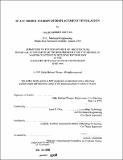| dc.contributor.advisor | Leon R. Glicksman, Leslie K. Norford. | en_US |
| dc.contributor.author | Okutan, Galip Mehmet | en_US |
| dc.contributor.other | Massachusetts Institute of Technology. Dept. of Architecture. | en_US |
| dc.date.accessioned | 2012-02-29T17:20:19Z | |
| dc.date.available | 2012-02-29T17:20:19Z | |
| dc.date.copyright | 1995 | en_US |
| dc.date.issued | 1995 | en_US |
| dc.identifier.uri | http://hdl.handle.net/1721.1/69338 | |
| dc.description | Thesis (M.S.)--Massachusetts Institute of Technology, Dept. of Architecture, 1995. | en_US |
| dc.description | Includes bibliographical references (leaves 144-146). | en_US |
| dc.description.abstract | Displacement ventilation is an air conditioning method that provides conditioned air to indoor environments with the goal to improve air quality while reducing energy consumption. This study investigates the performance of displacement ventilation systems in open plan office environments, focusing on vertical temperature stratification. It explores the possibility of improving the performance of these systems by reducing the temperature stratification at lower levels and allowing them to operate with high cooling loads without exceeding thermal comfort limits. An experimental setup consisting of a scale model of an open plan office room and equipment necessary to provide the experimental conditions was designed and constructed. Steady state experiments on displacement ventilation were conducted. The experiments simulated a variety of cases in terms of heat gain per area, air supply flow rate and slow mixing at lower levels. Temperature distributions in the model and fluid flow rates were measured. Flow visualization was performed to investigate the flow patterns in the office room. The vertical temperature profiles for the considered cases were not linear. The vertical temperature stratification increased when the heat gain in the office increased. It was within the comfort limits for all simulated cases, except the case with the maximum heat gain (38W/m2). The introduction of slow mixing at lower levels decreased the temperature differential in all experiments. This effect of slow mixing was more pronounced at lower heights. This suggested that displacement ventilation may accommodate higher cooling loads if slow mixing at the lower levels is provided. Flow visualization results indicated that the height of the stratification was about 1m above the floor. The plumes over the heat sources had different characteristics, implying the possible importance of the size, shape and spatial distribution of the heat sources. | en_US |
| dc.description.statementofresponsibility | by Galip Mehmet Okutan. | en_US |
| dc.format.extent | 191 leaves | en_US |
| dc.language.iso | eng | en_US |
| dc.publisher | Massachusetts Institute of Technology | en_US |
| dc.rights | M.I.T. theses are protected by
copyright. They may be viewed from this source for any purpose, but
reproduction or distribution in any format is prohibited without written
permission. See provided URL for inquiries about permission. | en_US |
| dc.rights.uri | http://dspace.mit.edu/handle/1721.1/7582 | en_US |
| dc.subject | Architecture. | en_US |
| dc.title | Scale model studies of displacement ventilation | en_US |
| dc.type | Thesis | en_US |
| dc.description.degree | M.S. | en_US |
| dc.contributor.department | Massachusetts Institute of Technology. Department of Architecture | |
| dc.identifier.oclc | 33337556 | en_US |
